The significance of Digital Twins in the A/E/C industry lies in their ability to bridge the gap between the physical and digital worlds.
In the rapidly advancing realm of technology, architects and engineers find themselves at the leading edge of innovation, adopting new tools and methodologies to shape the future of design and construction. One such revolutionary development that has taken the A/E/C world by storm is the concept of Digital Twins. This transformative technology has not only revolutionized the way designers approach their projects but has also opened up new realms of possibilities. In this article, JPT explores the designer’s perspective on a Digital Twin within a Healthcare Design project and the significance a Digital Twin has on the Facility Management of a Healthcare Environment.
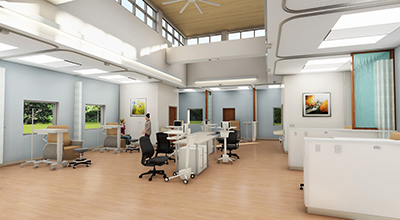
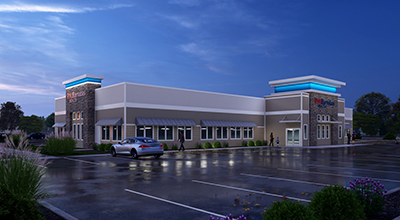
The Definition of a Digital Twin
A Digital Twin is a dynamic, virtual representation of a structure or piece of equipment, created using progressive digital modeling and simulation technologies. This virtual replica closely mirrors the characteristics, behavior and performance of its real-world counterpart, fostering the exploration of design options, performance analysis and the optimization of building functionality in a digital environment. A Digital Twin serves as a robust tool for designers enabling them to collaborate with stakeholders, simulate different scenarios and make informed decisions through the construction process.
In the realm of Healthcare Design, innovation is paramount to creating environments that encourage healing, efficiency and patient well-being. A Digital Twin examines the potential to revolutionize the way healthcare facilities are conceived, constructed and managed.
More than just BIM
A Digital Twin signifies a step forward in the A/E/C industry compared to traditional Building Information Modeling (BIM) systems. While BIM provides invaluable tools to create digital representations of structures, a Digital Twin takes the concept up a notch by integrating real-time data room sensors and other sources. This enables a Digital Twin to offer dynamic insights into building performance, occupancy patterns and environmental conditions which provides stakeholders with a comprehensive understanding of how a building operates in real-time.
Additionally, a Digital Twin supports the entire lifecycle of a building, from design and construction to operation and maintenance, while offering tools for ongoing management and optimization. With their enhanced simulation capabilities, collaborative features and adaptability to change, a Digital Twin allows stakeholders to make informed decisions and enhance building performance throughout the project lifecycle, making them a high-quality choice for modern A/E/C projects.
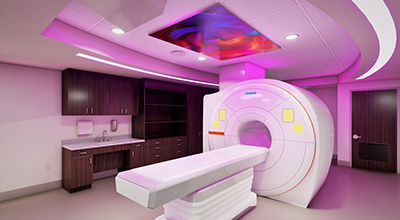
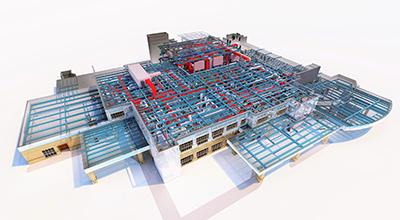
Positive Outcomes
Optimized Design & Planning: A Digital Twin enables designers to create extremely detailed virtual models of healthcare facilities. These models allow for the exact planning and layout of spaces, ensuring optimal utilization of resources and efficient workflows. Designers can simulate different layouts and scenarios and assess their impact on patient flow, staff efficiency and overall functionality, leading to more successful designs.
- Advanced Patient Experience: By simulating patient journeys and interactions with the built environment, a Digital Twin helps designers create patient-centric spaces that prioritize comfort, safety and well-being. Design decisions can be informed by real-time data on factors such as lighting, acoustics and environmental quality, resulting in environments that promote healing and reduce stress for patients and their families.
- Enhanced Operational Efficiency: A Digital Twin integrates real-time data on building performance, equipment status and occupancy patterns, allowing healthcare facilities to operate more efficiently. Engineers can monitor energy consumption, HVAC systems and other critical infrastructure components, identifying opportunities for optimization and cost savings. Predictive analytics can anticipate maintenance needs and prevent downtime, ensuring uninterrupted service delivery.
- Streamlined Construction Process: During the construction phase, a Digital Twin facilitates collaboration and coordination among project teams, reducing errors and delays. Contractors can use virtual models to visualize construction sequences, coordinate logistics and identify potential clashes before they occur. This proactive approach minimizes rework, accelerates project timelines and ultimately lowers construction costs.
- Support for Healthcare Technology Integration: A Digital Twin provides a platform for integrating and testing healthcare technologies, such as telemedicine systems, medical devices and smart sensors. Architects and engineers can design spaces that accommodate the latest technological advancements, ensuring seamless integration and optimal performance. A Digital Twin also supports ongoing upgrades and modifications as technology evolves, future-proofing healthcare facilities for years to come.
- Data-Driven Decision Making: By harnessing real-time data and advanced analytics, a Digital Twin empowers stakeholders to make informed decisions throughout the healthcare facility lifecycle. Architects, engineers and facility managers can access actionable insights on building performance, patient outcomes and operational efficiency, guiding strategic investments and continuous improvement initiatives.
Overall, a digital twin provides unparalleled benefits for Healthcare Design, driving innovation, efficiency and excellence in the design and operation of healthcare facilities. By leveraging the power of a Digital Twin, architects and engineers can create an environment that prioritizes patient care, enhances staff productivity and delivers superior healthcare outcomes.
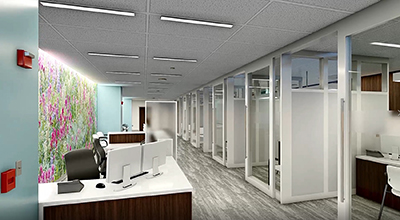
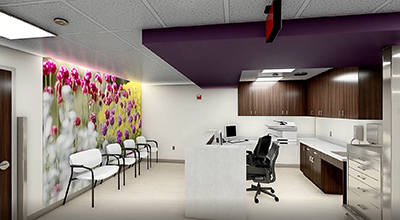
Facility Management
A Digital Twin offers many benefits to facility management in hospitals and other medical facilities by providing real time insights, predictive capabilities and streamlined operations. Here’s how a Digital Twin helps facility management in a hospital-type setting:
- Real Time Monitoring: A Digital Twin integrates data from various sensors and systems throughout the hospital, including HVAC, lighting, power, security and equipment.
- Predictive Maintenance: By investigating historical and real-time data, a Digital Twin enables predictive maintenance strategies for hospital equipment and infrastructure.
- Space Optimization: A Digital Twin provides insight into space utilization within the hospital, including patient rooms, waiting areas and clinical spaces.
- Energy Efficiency: A Digital Twin helps hospitals optimize energy usage and lower operating costs by monitoring and analyzing energy consumption patterns in real-time.
- Emergency Preparedness: A Digital Twin reinforces emergency preparedness and response efforts by providing real-time situational awareness and decision support tools.
- Regulatory Compliance: A Digital Twin simplifies compliance management and regulatory reporting techniques for hospitals.
A Digital Twin plays a critical role in enhancing facility management in hospitals by providing real-time insights, predictive capabilities and decision support tools. By leveraging the power of a Digital Twin, facility managers can optimize operations, improve patient care and ensure the efficient and sustainable operation of hospital facilities.
Overall, a Digital Twin serves as a powerful tool for the entire project team, facilitating collaboration, visualization, design optimization, simulation, coordination and operational efficiency across all stages of the project lifecycle. By harnessing the capabilities of a Digital Twin, project teams can deliver better-designed, more sustainable and efficiently operated buildings that meet the needs of stakeholders and occupants.
Make sure that you ask the architects and engineers on your next project if they are using a digital twin.